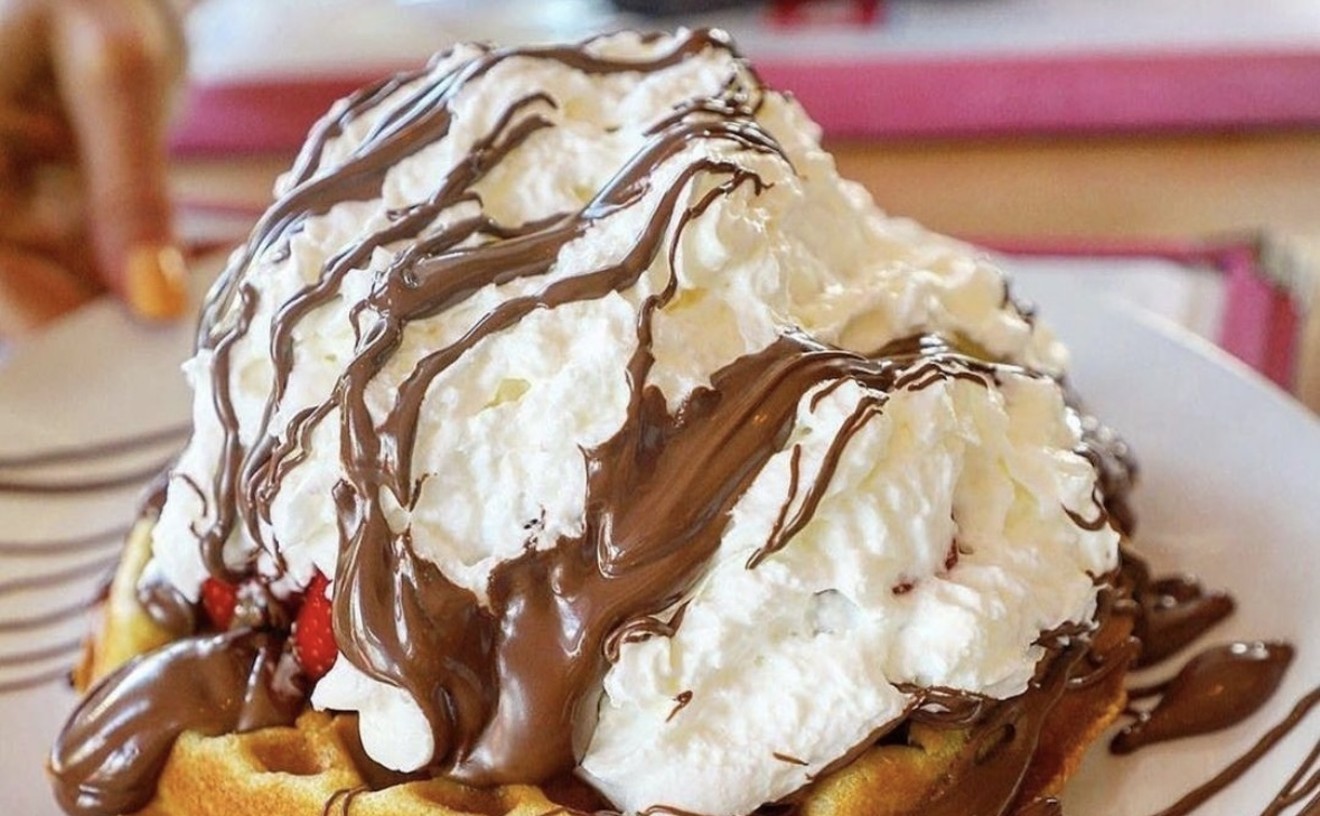For a moment I thought I had accidentally wandered into Barcelona Barry's: The appetizer selections lead off with a plate of serrano ham, chorizo, and Manchego cheese, followed by the classic potato-and-onion-filled Spanish tortilla. Later I'd learn that chef Dania Aguet, though Cuban, had schooled and trained in Spain for ten years. It was a bit of an overreaction on my part anyway, as the other starters were more Havana-oriented, like six fried plantain-breaded shrimp curled around a cup of middling mango dipping sauce with a bunch of crunchy malanga fritters on the side. Long thin strips of green plantain chips, called mariquitas, also were fried crisp and served with a shallow earthenware dish of ground beef picadillo (cooked with garlic, onions, peppers, raisins, green olives, and tomato sauce) and capped with melted mozzarella and cheddar cheese -- the Caribbean equivalent of chili and chips, without the chili powder. Biggest hit among the starters was fried pork, four humongous hunks of seared meat bathed in sautéed garlic and grilled onions. It was a juicy, tender, superior rendition of what in other places often is a plate of small dry pork nuggets.
Caldo gallego originated in the Spanish province of Galicia but has become one of Cuba's favorite soups. I like a hearty version, chock full of white beans, pork, potatoes, chorizo, cabbage, and kale, but apparently Harry prefers his more minimalist. The gallego here is made up mostly of smooth white beans and small shreds of the ham hock with which they're cooked -- undeniably fresh and wholesome tasting but underseasoned to the point of vapidity. Soup of the day, a milky white malanga cream chowder, was more conducive to such restraint, the understated potatolike flavor of the root coming through loud and clean.
One menu page of main courses is all beef, many prepared Argentine-style: churrasco (grilled skirt steak), palomilla (pounded steak), Milanesa (breaded and fried), rancho (grilled flank steak with mushroom sauce and melted mozzarella), and filet mignon with chimichurri sauce. We decided to do Argentina all the way with a special parrillada, at $24.95 the priciest meal available. A deftly grilled strip of flank steak arrived at the table with a trio of grilled shrimp and a grilled lobster tail that was moist and tasty but had the texture of having spent considerable time in the freezer between its last dip in the ocean and its first in boiling water. A dish of lemon-garlic butter came on the side; a coconut sauce, which was to accompany the shellfish, didn't.
Vaca frita is a traditional as well as economical meal in many Cuban households; it's made by frying onions and garlic with beef that's previously been used to make broth. Of course restaurants don't use stock-drenched meat when preparing this dish, which is a good thing, though just the same, we opted for lechoncita, a vaca frita-type mix of shredded pork, grilled onions, and mojo sauce. It turned out to be an unlucky pick, the shrapnel-like scraps of parched pork clearly overcooked. Other pork offerings include baby-back ribs with barbecue sauce and grilled chops with guava or criollo sauce, while the chicken courses, all made from the oh-so boring breast, are prepared in much the same manner as the beef: vaca frita, Milanesa, with mushroom sauce and melted mozzarella, and grilled with either mango or citrus sauce.
The page of special menu items, revised every month or so, is firmly rooted in fruitiness: Tuna gets topped with a tropical fruit sauce, chicken with guava barbecue sauce, snapper with Bacardi-pineapple, salmon with papaya, one shrimp dish with mango, another with sugar cane. Springtime snapper with crab and avocado sauce contained nothing fruity, unless you want to get technical and point to the avocado. Actually that would be hard to do, as the snippets of that creamy green fruit were invisibly buried, along with the broiled snapper, in an overwhelming tide of surimi (people mock the French for their love of Jerry Lewis, but I think the Japanese infatuation with this fake crab is just as puzzling) and a heavy cream sauce thickened with mayo and sour cream. The preparation was much heavier than its seasonal moniker let on, though I guess I should've known better than to order a “springtime” dish in October. All main courses are generously portioned and come with varying combinations of rice, congri, moros, mariquitas, sweet plantains, and black beans, which adds up to lots of food for a very reasonable price: starters from $3 to $8, main courses, excepting a few steaks, from $9 to $17. There also are four family-friendly children's dinners offered, each less than $5.
I skipped tres leches as always, because of its overwhelming sweetness. Bypassed the cuatro leches, too, of course, but in fact there's no getting around glucose gluttony with this selection of desserts, so I relinquished my resistance and ordered what turned out to be a light and foamy cheesecake covered by a surprisingly compatible coat of dulce de leche. Crema catalana also was gratifying, the crackly candied crust providing a bit of bitter overlay to the creamiest of custards. Coconut bread pudding, absolutely soaked in coconut milk and pooled in coconut and Bacardi rum sauce, was intensely flavorful, though I don't think even a cinco leches could have been sweeter. Overall desserts are as good as you'll find in Latin restaurants charging twice as much, which pretty much sums up Havana Harry's appeal. You can find better Cuban food and cheaper Cuban food, but you'd be hard-pressed to find better Cuban food at cheaper prices.











